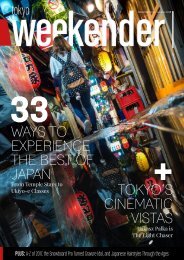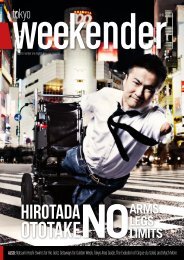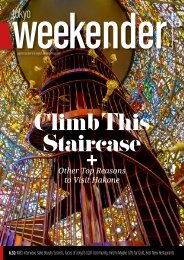Tokyo Weekender - October 2017
A day in the life of a geisha. Find your perfect Kyushu. Plus Q&A with anime director Keiichi Hara, are robots taking our jobs?, Explore Japanese cuisine at GINZA SIX, and Tsukuda guide
A day in the life of a geisha. Find your perfect Kyushu. Plus Q&A with anime director Keiichi Hara, are robots taking our jobs?, Explore Japanese cuisine at GINZA SIX, and Tsukuda guide
You also want an ePaper? Increase the reach of your titles
YUMPU automatically turns print PDFs into web optimized ePapers that Google loves.
[ PROMOTION ]<br />
DAY 1<br />
Trip 4:<br />
FOR HISTORY BUFFS<br />
Kumamoto, Saga, Nagasaki Prefectures<br />
KUMAMOTO CASTLE<br />
Although you’ll be missing out on actually<br />
seeing its impressive facade, which<br />
is covered in scaffolding as they rebuild<br />
after the 2016 Kumamoto earthquakes,<br />
now is an enlightening time to visit<br />
Kumamoto Castle. It’s one of the few<br />
places in Japan that you can currently<br />
examine the extensive damage and<br />
restoration efforts necessary after an<br />
earthquake hits such a historically<br />
important structure. Built in 1607, the<br />
castle is scheduled to reopen to the<br />
public in early 2019, but the entire<br />
recovery process is expected to take two<br />
decades, mainly because consideration<br />
must be taken to maintain the traditional<br />
structure – for example, every stone<br />
that fell from the massive walls during<br />
the earthquake must be put back into<br />
its original position. When we visited,<br />
we were entranced by the watchtower<br />
alone, which stands tall and proud and<br />
largely intact. We were also astounded<br />
by one huge stone on display, which<br />
was discovered after the earthquake<br />
and features an ancient stone carving of<br />
a Bodhisattva figure.<br />
DAY 2<br />
SAGA'S YOSHINOGARI HISTORICAL PARK<br />
There’s plenty to do and see in Saga Prefecture (see page 22), but for some fascinating insight<br />
into one of Japan’s oldest periods, we recommend visiting Yoshinogari Historical Park<br />
(www.yoshinogari.jp/en). This archeological site features ancient ruins of a king’s village<br />
dating back to the Yayoi period (300BCE-300ACE), with reconstructed huts showing how<br />
people lived and the clothes they wore. Aside from simply trying to imagine what it must<br />
have been like to live in that era, the most intriguing part of our visit was inspecting the<br />
excavated burial jars and the various artifacts that were found inside them such as bronze<br />
swords and glass jewelry.<br />
HOW TO GET THERE If you<br />
stayed at Satsuki Besso ryokan<br />
as recommended for Day 1, then<br />
take the Kyushu Shinkansen from<br />
Shin-Tamana Station to Shin-Tosu<br />
Station (about 25 minutes).<br />
Change to the JR Nagasaki Line<br />
and travel for 10 minutes to<br />
Yoshinogari-Koen Station.<br />
WHERE TO STAY End your day<br />
in Saga’s famous Ureshino onsen<br />
town. We stayed at Warakuen<br />
(www.warakuen.co.jp/english.<br />
html), which has a unique "tea<br />
hot spring." To get here, take the<br />
JR Kyushu Nagasaki Line from<br />
Yoshinogari-Koen Station to<br />
Hizen-Kashima Station, and then<br />
a short taxi ride.<br />
NAGASAKI ATOMIC BOMB MUSEUM & GLOVER GARDEN<br />
The Nagasaki Atomic Bomb Museum is a sobering start to the day, but it’s also thoroughly<br />
educational and an important reminder of the horror and devastation endured by the city<br />
and its people. For a completely different side to Nagasaki’s history, hop on the city tram<br />
to Glover Garden, where you can see the house built by Thomas Blake in 1863. Originally<br />
from Scotland, Glover contributed to the modernization of Japan through shipbuilding, coal<br />
mining and the tea trade. Those who’ve recently watched Martin Scorcese’s film Silence<br />
might be interested in reading about the “hidden Christian sites” in the region, one of<br />
which, Oura Cathedral, is just down the road from Glover’s home. Also, don’t leave without<br />
chowing down on Nagasaki’s popular champon noodles.<br />
DAY 3<br />
HOW TO GET THERE You can fly<br />
from <strong>Tokyo</strong> to Kumamoto in about<br />
two hours, but if you’re traveling from<br />
Kagoshima (following on from Trip 3),<br />
then take the Kyushu Shinkansen from<br />
Kagoshima-Chuo Station to Kumamoto<br />
Station (about one hour).<br />
WHERE TO STAY Since Day 2 of our<br />
History Buff trip starts with a relatively<br />
long journey, we’d recommend getting<br />
part of the train ride under your belt by<br />
staying at Satsuki Besso ryokan, which is<br />
about 30 minutes out of the city towards<br />
Saga Prefecture. Take the Kyushu<br />
Shinkansen from Kumamoto Station to<br />
Shin-Tamana Station, and then walk for<br />
25 minutes or hop in a taxi.<br />
HOW TO<br />
GET THERE<br />
If you’re<br />
coming from<br />
Ureshino, take<br />
JR Kyushu's<br />
Limited Express Kamome train from<br />
Hizen-Kashima Station to Nagasaki<br />
Station, and then navigate your way<br />
around the city on the adorable<br />
tramway, founded in 1915.<br />
WHERE TO STAY Huis Ten Bosch<br />
theme park is modeled on what<br />
the Netherlands looked like in the<br />
Middle Ages. There are four hotels,<br />
with Henn-na Hotel being the<br />
world’s first hotel to feature robot<br />
staff. english.huistenbosch.co.jp<br />
TOKYO WEEKENDER | OCTOBER <strong>2017</strong> | 21
















